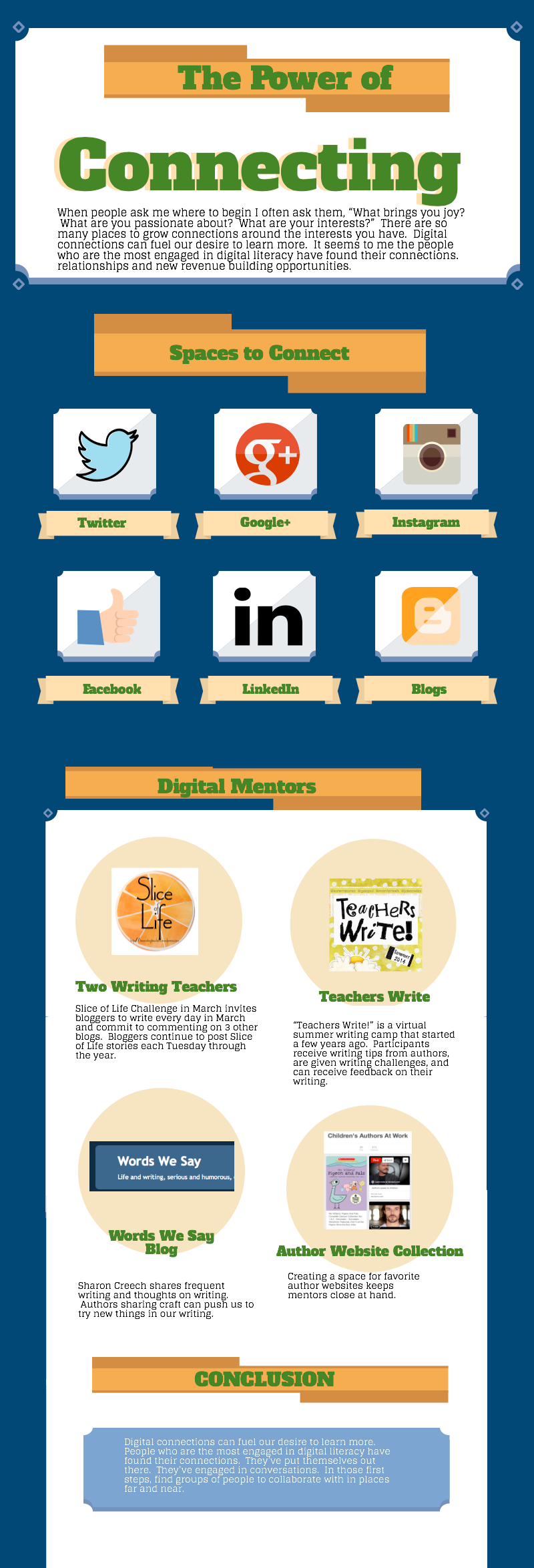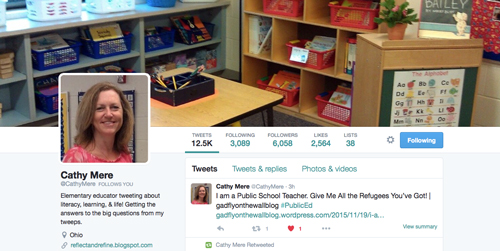Chapter 1: Transitioning Toward Digital Literacy
1.4 Power of Connecting
In those first days I began to discover, not only purposes for digital tools but, the power of connecting with others. If you think about the places you enjoy spending time, it’s probably because you feel like you belong there. It might be at family gatherings, your book club, the gym, or a monthly lunch with friends. It is in these places you feel connected. The power in digital literacy is in the deliberate connections we make and the variety of spaces we can use to grow these connections. Part of what changed my thinking about using digital literacy was the connections I began to make with other educators. These educators made me think of new things, allowed me to peek inside their classrooms, connected me with new learning, and kept my to-be-read pile stacked.
Connecting to Groups Who Have Similar Interests:
There are also groups of people connected in common sharing of information. As I spent time reading blogs and following people on Twitter, I began to discover other groups with similar interests. These groups often share information related to a topic or interest. There are often conversations that take place around these ideas or posts that are written to share information. Some of these groups have regularly scheduled chat or posts times; others connect as needed. Since poetry is an interest of mine, I looked for other people interested in poetry. In this search I discovered educators, writers, and poets who shared poetry every Friday. This event, Poetry Friday, has a host blog each week where people link to share poems or poetry resources. I consider these communities to be more stable and ongoing. Hashtags on Twitter can help to find groups with similar interests. I began to follow the conversations of #1stchat, #titletalk, #nerdybookclub, #twtblog, #tcrwp and #edchat. These conversations helped me to connect with people who have similar interests. Often these groups host scheduled conversations and continue to connect using the hashtag. Connecting through hashtags often leads to more interactive conversations and collaboration. You can find out more about these conversations at Cybraryman’s website: Chats (https://sites.google.com/site/twittereducationchats/education-chat-calendar). Some digital connections are short term or focused around particular events. Donalyn Miller started a summer reading challenge under the hashtag: #bookaday. Participants tackle the challenge of daily reading.
Mandy Robek and I host a picture book event each August in which teachers, parents, media specialists, and book lovers share the ten picture books they can’t live without. There’s also a nonfiction picture book link-up in February. These lists are then shared in the Picture Book 10 for 10 learning community.
Connecting to Groups for Deeper Learning:
Going digital has really changed professional development for me. I no longer rely on professional development provided in sessions and lectures. Instead, I have been able to reach out to learn in digital spaces and learning communities. These communities continually push my thinking and offer share new possibilities. Along the way I also began to join and lead digital groups for more intensive study. With the help of Jill Fisch, Laura Komos, and Michelle Nero we created a group to digitally discuss one professional title each July. Our community, #cyberPD (https://plus.google.com/u/0/communities/107711243109928665922), has grown from less than fifteen to over one hundred since it began five years ago. I’ve also joined MOOCs (Massive Open Online Course) in which groups of people join together under common study to learn and/or create together. Recently, Julie Johnson and I hosted the Digital Maker Playground: a space where learners were able to play, create, and collaborate with other learners globally. I’m also participating in CLMOOC (http://clmooc.educatorinnovator.org/2015/) which is MOOCs provide a space for learning together. I find I discover new ideas working alongside other digital learners.
Connecting to Other Readers
Becoming digital has really changed the way I find books to read. Most books I read now are books I’ve discovered through blogs or on Twitter. “It’s Monday, What Are You Reading” is a meme started by Sheila DeChantal of Book Journeys and moved into the kidlitosphere by Jennifer Vincent of Teach Mentor Texts and Kellee Moye of Unleashing Readers. There are also several blogs I count on for book recommendations. Aly Beecher hosts a weekly challenge for participants interested in getting to know more about nonfiction picture books and sharing their finds with other readers. My to-be-read pile is always stacked with titles I plan to read thanks to the many readers who take the time to blog about books. A few of my favorites include: A Year of Reading, Mary Lee Hahn & Franki Sibberson, There’s a Book for That: Carrie Gelson, KidLit Frenzy: Aly Beecher, Teach Mentor Texts: Jennifer Vincent. I also count on readers like Katherine Sokolwoski, Karen Terlecky, and Margie Myers-Culver on Twitter to share titles.

